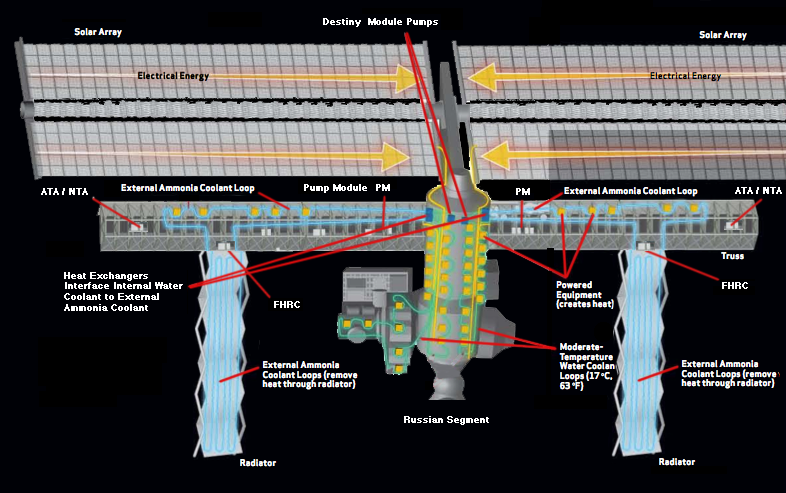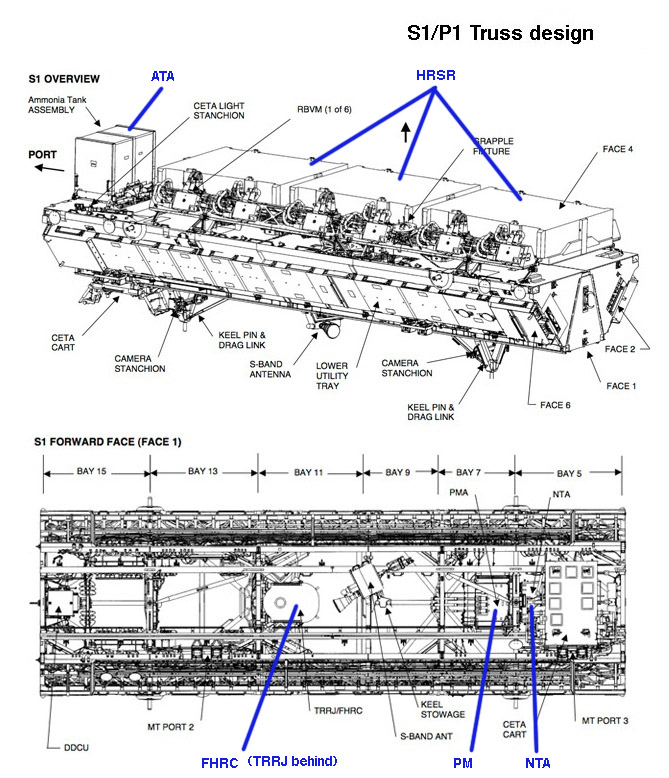External Active Thermal Control System on:
[Wikipedia]
[Google]
[Amazon]


 The
The 
File:02 PM on thr LMC for STS-131 2010-2215.jpg, Pump Module (PM)
File:Pump Module with fixed grapple bar and MLI illustrations.png, PM drawing
File:03 NTA.jpg, Nitrogen Tank Assembly (NTA)
File:NTA.png, NTA drawing (cover removed)
File:STS-128 EVA2 Danny Olivas 1.jpg, Ammonia Tank Assembly (ATA)
File:ATA.png, ATA drawing (cover removed)
File:01 FHRC sts126 fhrc.jpg, Flex Hose Rotary Coupler (FHRC)
File:FHRC without MLI cover STS-128.png, FHRC without MLI cover and in situ on the TRRJ
File:HRSR.png, Heat Rejection System Radiator (HRSR)
File:HRS.png, HRSR drawing




 The
The International Space Station
The International Space Station (ISS) is the largest modular space station currently in low Earth orbit. It is a multinational collaborative project involving five participating space agencies: NASA (United States), Roscosmos (Russia), JAXA ( ...
(ISS) External Active Thermal Control System (EATCS) maintains an equilibrium when the ISS environment or heat loads exceed the capabilities of the Passive Thermal Control System (PTCS). Note Elements of the PTCS are external surface materials, insulation such as Multi-Layer Insulation
Multi-layer insulation (MLI) is thermal insulation composed of multiple layers of thin sheets and is often used on spacecraft and cryogenics. Also referred to as superinsulation, MLI is one of the main items of the spacecraft thermal design, pri ...
(MLI), or Heat Pipes. The EATCS provides heat rejection capabilities for all the U.S. pressurized modules, the Japanese Experiment Module
Japanese may refer to:
* Something from or related to Japan, an island country in East Asia
* Japanese language, spoken mainly in Japan
* Japanese people, the ethnic group that identifies with Japan through ancestry or culture
** Japanese diaspor ...
(JEM), the Columbus Orbital Facility (COF), and the main power distribution electronics of the S0, S1 and P1 Trusses. The EATCS consists of two independent Loops (Loop A & Loop B), which both use mechanically pumped fluid state ammonia
Ammonia is an inorganic compound of nitrogen and hydrogen with the formula . A stable binary hydride, and the simplest pnictogen hydride, ammonia is a colourless gas with a distinct pungent smell. Biologically, it is a common nitrogenous wa ...
in closed-loop circuits. The EATCS is capable of rejecting up to 70 kW, and provides a substantial upgrade in heat rejection capacity from the 14 kW capability of the Early External Active Thermal Control System (EEATCS) via the Early Ammonia Servicer (EAS), which was launched on STS-105
STS-105 was a mission of the Space Shuttle ''Discovery'' to the International Space Station, launched from Kennedy Space Center, Florida, 10 August 2001. This mission was ''Discoverys final mission until STS-114, because ''Discovery'' was gro ...
and installed onto the P6 Truss.
There are two independent Loops (Loop A & Loop B) that combined make up the EATCS. The EATCS Loops perform three primary functions:
* Heat Collection - Each Loop draws heat from five Heat Exchangers (HXs) mounted on the Destiny Laboratory, Node-2 & Node-3 as well as cold plates under three DC-to-DC Conversion Units (DDCUs) (one DDCU each on each Loop on the P1/S1 Trusses and two DDCUs each on each Loop on the S0 Truss) and two Main Bus Switching Units (MBSUs) on each Loop on the S0 Truss (see schematic below and Orbital Replacement Unit
Orbital replacement units (or on-orbit replaceable unit) (ORUs) are key elements of the International Space Station that can be readily replaced when the unit either passes its design life or fails. ORUs are parts of the main systems and subsystems ...
s (ORUs) for design of these units);
* Heat Transportation - The Pump Module (PM) provides flow and accumulator functions and maintains proper temperature control at the pump outlet for each Loop. The PM consists of a single pump, a fixed charge accumulator, a Pump & Control Valve Package (PCVP) containing a firmware controller, startup heaters, isolation valves, and various sensors for monitoring performance. The Nitrogen Tank Assembly (NTA) controls the flow of ammonia out of the Ammonia Tank Assembly (ATA). The ATA contains two flexible, chambers incorporated into its ammonia tanks that expand as pressurized nitrogen from the NTA expels liquid ammonia out of the ATA. The major components in the ATA include two ammonia storage tanks, isolation valves, heaters, and various temperature, pressure, and quantity sensors;
* Heat Rejection - Ammonia passes from the ATA through a two way path of the Flex Hose Rotary Coupler (FHRC) where heat captured while passing through the Heat Exchangers is directed to be expelled through the Heat Rejection System Radiators (HRSRs). The radiators are rotated by the Thermal Rotary Radiator Joint (TRRJ) which continually rotates the radiator wing for optimum cooling.



References
{{ReflistSee also
*International Space Station
The International Space Station (ISS) is the largest modular space station currently in low Earth orbit. It is a multinational collaborative project involving five participating space agencies: NASA (United States), Roscosmos (Russia), JAXA ( ...
(ISS)
*Integrated Truss Structure
The Integrated Truss Structure (ITS) of the International Space Station (ISS) consists of a linear arranged sequence of connected trusses on which various unpressurized components are mounted such as logistics carriers, radiators, solar arrays, ...
(ITS)
*Orbital Replacement Unit
Orbital replacement units (or on-orbit replaceable unit) (ORUs) are key elements of the International Space Station that can be readily replaced when the unit either passes its design life or fails. ORUs are parts of the main systems and subsystems ...
s (ORUs)
*Electrical system of the International Space Station
The electrical system of the International Space Station is a critical resource for the International Space Station (ISS) because it allows the crew to live comfortably, to safely operate the station, and to perform scientific experiments. The ...
* Environmental Control and Life Support System (ECLSS)
* Integrated Cargo Carrier (ICCs)
*External Stowage Platform
External stowage platforms (ESPs) are key components of the International Space Station (ISS). Each platform is made from steel and serves as an external pallet that can hold spare parts, also known as orbital replacement units (ORUs), for the spa ...
(ESPs)
* ExPRESS Logistics Carrier (ELCs)
* Scientific research on the ISS
Components of the International Space Station